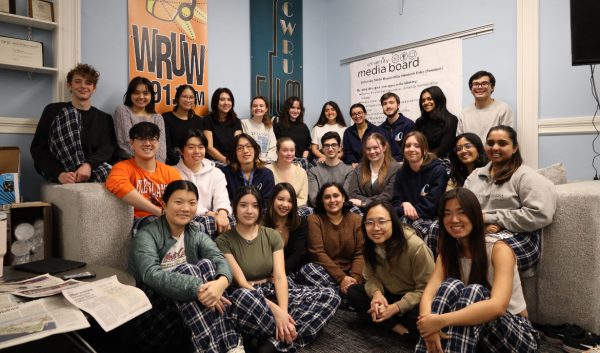Editorial: Caution is key to change in admissions process
The student body must deliberate on move to need-aware process and the Coalition Application
The retention rate of Case Western Reserve University leaves much to be desired. Of a class, 64 percent will graduate in four years, 80 percent in six years. Mental health and academic rigor may play a role in exacerbating the situation, but another, tuition, is vital to consider: CWRU currently only meets 70 percent of the financial aid needed by its students.
The Editorial Board does not believe that the CWRU administration or its students can make a decision on the admissions process without realizing the importance of meeting student financial need, and that the current financial pressures cannot continue unaddressed.
CWRU currently uses a need-blind admissions process. Just as it sounds,the admissions committee is not aware of what financial needs a student may have when evaluating their application. This means that whether you fall under the highest or lowest income brackets, whether you are admitted or not solely depends on what is on your application (namely your GPA, standardized tests, extracurriculars, work, letters of recommendation and essays). By not taking wealth into account, the process is considered to be extremely fair to individuals of all economic levels.
This exception is for international students and those admitted of the waitlist. These processes are ‘need-aware’, in which the admissions committee is aware of the student’s financial needs when deciding whether to admit them.
However, CWRU administration is considering switching all applicants to a need-aware admission system.
Need-aware admissions
We know that the administration has been aware of the low retention rate and has even prepared a large “Student Retention Task Force” to face the issue upfront. They also know that, in recent years, the proportion of low-income students enrolling has decreased.
The administration’s proposed solution is to take a student’s financial situation into account when choosing to admit them. By balancing their needs, CWRU would be able to meet 100 percent of financial need of all students.The argument is that this would increase the number of low-income students at CWRU.
The most immediate problem with this proposal is that there is no safeguard to prevent the admissions committee from discriminating against low-income students. Washington University in St. Louis is need-aware and only accepts about seven percent of students who receive Pell grants, a benchmark of low-income. As 50 percent of students can pay full tuition there, the university clearly sees the money pile the policy can create. Without a built-in check against the admissions committee, CWRU might fall prey to this Romeo of cash.
Even then, a need-aware policy would require a guarded implementation. A telling side-effect of the practice would be a “squeeze” on middle-tier income students. In reality students cannot fairly be placed into three income levels, but it is possible that fewer students with families in the middle 50 percent range will be admitted. In an attempt to increase the number of low-income students, CWRU would also need to accept a balancing amount of high-income students, resulting in fewer within the middle range.
To add to the complexity, one proposal that CWRU administrators have pitched is to admit 90 percent of students need-blind, and then the final 10 percent under a need-aware process. The solution has its merits, it would allow a majority of the students to be admitted without taking their financial needs taken into a consideration. The last 10 percent of admittances would still face the dangers described above, however, and more drastically, as the admissions committee would have fewer number of students to balance the financial aid scorecard.
Despite these objections, the Editorial Board still believes that it is worth having a conversation about switching to a need-aware admissions process.
Staying in a need-blind situation, CWRU would need to increase their annual budget by $15-20 million to meet 100 percent of financial need. To do this, CWRU would have to increase its endowment by an imposing $500 million. It’s not possible for that to happen quickly.
With a sad graduation rate and financial stress on students, it is high time to consider all options.
Coalition Application
What forced the conversation now is a potential switch to the Coalition Application, an alternative to the Common Application. In order to join the 80 universities set to use the coalition application in the 2017-2018 application cycle, CWRU would have to meet 100 percent financial aid.
The Board is more concerned about an immediate switch to the coalition application over implementing a need-aware system.
The new application takes a portfolio approach. Students can begin to submit items in the ninth grade and would continue to do so throughout their high school career. It came about from a mixture of frustration with a lack of a competitor for the Common Application.
However, most importantly for CWRU to forgo the application might mean to lose out on high achieving students that use it to apply.
The most obvious problem with the coalition app is that students at high schools with strained advising resources will face an uphill battle. (Did you meet counselors at your high school to talk about college the very first day of school?) The application is untested, and given its overtime portfolio approach, students applying wouldn’t have had the opportunity to use it to its full potential for several years.
It would also result in a hastily designed need-aware admissions system. A fractured need-aware system should be avoided at all costs since it won’t offer any of the safeguards to low-income students.
Need for debate
For the Board, the most encouraging aspect of this discussion, given the potential time crunch, is that the administration didn’t overstep and unilaterally introduce both proposals. The administration has also worked closely with the Undergraduate Student Government (USG), which will in the end represent the student opinion. Vice President Richard Bischoff presented the proposals to a public USG general body meeting last week on Nov. 3, and answered questions from those present. The USG Vice President of Academic Affairs, Nishant Uppal, then raised some questions at that meeting.
Last Tuesday, Nov. 10, USG Vice President of finance Brian Ward emailed all student organization leaders notifying them that USG is planning an open forum. We encourage students to submit their opinions to USG at the email found in the newsletter they sent out last Friday, Nov. 6 and to attend future open forums.
An open conversation among the student body about the pros and cons of changing the admissions processes will allow for a better decision. Until that happens, the Board urges restraint in making changes to the current need-blind, Common Application-based admission process.
We’re not in support of a need-aware process, itself, but recognize that there may be a need for some sort of change in the admissions process.
The current path CWRU is on puts a large burden on students attending and lowers their chances of graduating. There are serious perils to a need-aware system that need to be addressed before moving forward with the process as a potential solution to the present dire situation.
Unsigned editorials are typically written by the opinion editor but reflect the majority opinion of the senior editorial staff.














